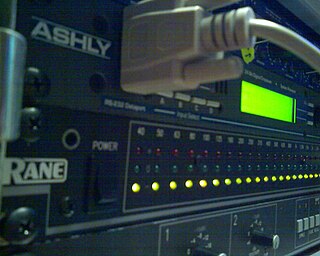- Third Octave Analysis
- FFT
- Frequency Response Function
- Color Map
- Dual-FFT frequency response of an active crossover as measured using Smaart software
Related Research Articles
In electronics, the figures of merit of an amplifier are numerical measures that characterize its properties and performance. Figures of merit can be given as a list of specifications that include properties such as gain, bandwidth, noise and linearity, among others listed in this article. Figures of merit are important for determining the suitability of a particular amplifier for an intended use.

In electronics, an analog-to-digital converter is a system that converts an analog signal, such as a sound picked up by a microphone or light entering a digital camera, into a digital signal. An ADC may also provide an isolated measurement such as an electronic device that converts an analog input voltage or current to a digital number representing the magnitude of the voltage or current. Typically the digital output is a two's complement binary number that is proportional to the input, but there are other possibilities.

A microphone, colloquially called a mic, is a transducer that converts sound into an electrical signal. Microphones are used in many applications such as telephones, hearing aids, public address systems for concert halls and public events, motion picture production, live and recorded audio engineering, sound recording, two-way radios, megaphones, and radio and television broadcasting. They are also used in computers and other electronic devices, such as mobile phones, for recording sounds, speech recognition, VoIP, and other purposes, such as ultrasonic sensors or knock sensors.
A transducer is a device that converts energy from one form to another. Usually a transducer converts a signal in one form of energy to a signal in another. Transducers are often employed at the boundaries of automation, measurement, and control systems, where electrical signals are converted to and from other physical quantities. The process of converting one form of energy to another is known as transduction.
In signal processing and electronics, the frequency response of a system is the quantitative measure of the magnitude and phase of the output as a function of input frequency. The frequency response is widely used in the design and analysis of systems, such as audio and control systems, where they simplify mathematical analysis by converting governing differential equations into algebraic equations. In an audio system, it may be used to minimize audible distortion by designing components so that the overall response is as flat (uniform) as possible across the system's bandwidth. In control systems, such as a vehicle's cruise control, it may be used to assess system stability, often through the use of Bode plots. Systems with a specific frequency response can be designed using analog and digital filters.

Audio system measurements are a means of quantifying system performance. These measurements are made for several purposes. Designers take measurements so that they can specify the performance of a piece of equipment. Maintenance engineers make them to ensure equipment is still working to specification, or to ensure that the cumulative defects of an audio path are within limits considered acceptable. Audio system measurements often accommodate psychoacoustic principles to measure the system in a way that relates to human hearing.

A spectrum analyzer measures the magnitude of an input signal versus frequency within the full frequency range of the instrument. The primary use is to measure the power of the spectrum of known and unknown signals. The input signal that most common spectrum analyzers measure is electrical; however, spectral compositions of other signals, such as acoustic pressure waves and optical light waves, can be considered through the use of an appropriate transducer. Spectrum analyzers for other types of signals also exist, such as optical spectrum analyzers which use direct optical techniques such as a monochromator to make measurements.

A sound reinforcement system is the combination of microphones, signal processors, amplifiers, and loudspeakers in enclosures all controlled by a mixing console that makes live or pre-recorded sounds louder and may also distribute those sounds to a larger or more distant audience. In many situations, a sound reinforcement system is also used to enhance or alter the sound of the sources on the stage, typically by using electronic effects, such as reverb, as opposed to simply amplifying the sources unaltered.
Condition monitoring is the process of monitoring a parameter of condition in machinery, in order to identify a significant change which is indicative of a developing fault. It is a major component of predictive maintenance. The use of condition monitoring allows maintenance to be scheduled, or other actions to be taken to prevent consequential damages and avoid its consequences. Condition monitoring has a unique benefit in that conditions that would shorten normal lifespan can be addressed before they develop into a major failure. Condition monitoring techniques are normally used on rotating equipment, auxiliary systems and other machinery like belt-driven equipment,, while periodic inspection using non-destructive testing (NDT) techniques and fit for service (FFS) evaluation are used for static plant equipment such as steam boilers, piping and heat exchangers.
In electronics and signal processing, signal conditioning is the manipulation of an analog signal in such a way that it meets the requirements of the next stage for further processing.
Noise, vibration, and harshness (NVH), also known as noise and vibration (N&V), is the study and modification of the noise and vibration characteristics of vehicles, particularly cars and trucks. While noise and vibration can be readily measured, harshness is a subjective quality, and is measured either via jury evaluations, or with analytical tools that can provide results reflecting human subjective impressions. The latter tools belong to the field psychoacoustics.

A real-time analyzer (RTA) is a professional audio device that measures and displays the frequency spectrum of an audio signal; a spectrum analyzer that works in real time. An RTA can range from a small PDA-sized device to a rack-mounted hardware unit to software running on a laptop. It works by measuring and displaying sound input, often from an integrated microphone or with a signal from a PA system. Basic RTAs show three measurements per octave at 3 or 6 dB increments; sophisticated software solutions can show 24 or more measurements per octave as well as 0.1 dB resolution.

Ultrasonic transducers and ultrasonic sensors are devices that generate or sense ultrasound energy. They can be divided into three broad categories: transmitters, receivers and transceivers. Transmitters convert electrical signals into ultrasound, receivers convert ultrasound into electrical signals, and transceivers can both transmit and receive ultrasound.

An oscilloscope is a type of electronic test instrument that graphically displays varying voltages of one or more signals as a function of time. Their main purpose is capturing information on electrical signals for debugging, analysis, or characterization. The displayed waveform can then be analyzed for properties such as amplitude, frequency, rise time, time interval, distortion, and others. Originally, calculation of these values required manually measuring the waveform against the scales built into the screen of the instrument. Modern digital instruments may calculate and display these properties directly.

Brüel & Kjær is a Danish multinational engineering and electronics company headquartered in Nærum, near Copenhagen. It was the largest producer in the world of equipment for acoustic and vibrational measurements. Brüel & Kjær is a subsidiary of Spectris.

Smaart is a suite of audio and acoustical measurements and instrumentation software tools introduced in 1996 by JBL's professional audio division. It is designed to help the live sound engineer optimize sound reinforcement systems before public performance and actively monitor acoustical parameters in real time while an audio system is in use. Most earlier analysis systems required specific test signals sent through the sound system, ones that would be unpleasant for the audience to hear. Smaart is a source-independent analyzer and therefore will work effectively with a variety of test signals including speech or music.
Pyroshock, also known as pyrotechnic shock, is the dynamic structural shock that occurs when an explosion or impact occurs on a structure. Davie and Bateman describe it as: "Pyroshock is the response of a structure to high frequency, high-magnitude stress waves that propagate throughout the structure as a result of an explosive event such as an explosive charge to separate two stages of a multistage rocket." It is of particular relevance to the defense and aerospace industries in that they utilize many vehicles and/or components that use explosive devices to accomplish mission tasks. Examples include rocket stage separation, missile payload deployment, pilot ejection, automobile airbag inflators, etc. Of significance is the survival and integrity of the equipment after the explosive device has activated so that the vehicle can accomplish its task. There are examples of flight vehicles Boeing-The Aerospace Corp which have crashed after a routine explosive device deployment, the cause of the crash being determined as be a result of a computer failure due to the explosive device. The resultant energies are often high g-force and high frequency which can cause problems for electronic components which have small items with resonant frequencies near those induced by the pyroshock.

An audio analyzer is a test and measurement instrument used to objectively quantify the audio performance of electronic and electro-acoustical devices. Audio quality metrics cover a wide variety of parameters, including level, gain, noise, harmonic and intermodulation distortion, frequency response, relative phase of signals, interchannel crosstalk, and more. In addition, many manufacturers have requirements for behavior and connectivity of audio devices that require specific tests and confirmations.
An acoustic camera is an imaging device used to locate sound sources and to characterize them. It consists of a group of microphones, also called a microphone array, from which signals are simultaneously collected and processed to form a representation of the location of the sound sources.
3D sound localization refers to an acoustic technology that is used to locate the source of a sound in a three-dimensional space. The source location is usually determined by the direction of the incoming sound waves and the distance between the source and sensors. It involves the structure arrangement design of the sensors and signal processing techniques.
References
- ↑ G.R.A.S. Sound & Vibration has a selection guide Archived 2015-08-07 at the Wayback Machine detailing the difference between microphones.
- ↑ Measurement Microphones & Acoustic Test Accessories




